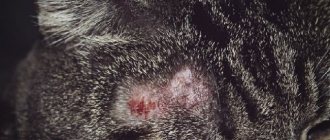The liver can be compared to a filter, since it passes blood through itself, simultaneously purifying it. And naturally, the result of such filtration will be the sedimentation of harmful substances in the liver. Subsequently, for this reason, pets begin to develop the following diseases: helminthiases, infections, etc. Many cat owners do not accept chemicals for treating pathologies, so they use homeopathic remedies. One of these is “Covertal”, it is actively used for the treatment of hepatosis, as well as for infectious diseases. In this article we will tell you more about this drug.
Instructions for use
In order to open a bottle of solution, it is important to first remove the protective layer from the foil. You can draw the solution into a syringe without uncorking the rubber stopper; just wipe it with an alcohol solution and then pierce it with a needle. Then you can draw the required amount of the drug into the syringe.
It is allowed to give injections to the cat under the skin in the withers area or in the femoral muscle. The first option is more preferable, since the pet behaves calmly when taken by the withers.
It is important to follow a strict injection schedule. Because if you miss at least 1 injection, the effectiveness of treatment is significantly reduced.
Video subcutaneous injection at home
How to use Covertal
If indicated, Covertal should be administered to cats intramuscularly or subcutaneously. These injections can be done independently at home. Intramuscular injections lead to faster results, but for an inexperienced cat owner, the option of a subcutaneous injection (in the withers) is more suitable.
The cat owner can give his pet subcutaneous injections himself.
I always give all the injections to cats myself, but my sister does not have such skills. When Donut (sister’s cat) got sick, he was prescribed medications that needed to be injected just into the withers. I didn’t have the opportunity to visit her, so we called via video conference. She was able to get the first injection despite all her fears. The most difficult thing in this matter was fixing the cat in the desired position. To keep Donut from twitching, she put a clean sock on his head.
Video: how to give a painless injection to a cat yourself
Cat treatment plan
For chronic liver damage, Covertal should be administered 3 times a week. The course of treatment can last up to 1.5 months (depending on the complexity of the diagnosis). If the cat suffers from an acute form of the disease, then injections should be done daily (1 or 2 times) for 2 weeks. If the symptoms of the disease have not disappeared, the course can be repeated, but the manufacturer does not recommend exceeding the 2-week norm.
In any case, it is not recommended to skip the next injection. After all, homeopathy is a mild-acting medicine, so the effect of their use is most often cumulative. If an injection is missed, the treatment regimen should be continued as usual and with the same dosage.
Table: Covertal dosage
| Cat weight | Single dose |
| From 1.5 to 3 kg | Up to 0.3 ml |
| From 3 to 5 kg | Up to 0.5 ml |
| From 5 to 10 kg | Up to 1 ml |
From personal experience, I know that such dosages are not always convenient. It is not always possible to obtain the required dose with a regular syringe. A more convenient insulin syringe can also be purchased at a human pharmacy. Its scale is smaller and the sleeve is thinner, so it is easier to see the level of the solution in the syringe. In addition, such syringes have a thinner and shorter needle (which means the injection will be less painful).
Small doses of drugs are more convenient to administer with small syringes
Compatibility with other drugs
Covertal can be used together with other drugs. The combination of homeopathic, symptomatic and pathogenetic drugs depends on the specific diagnosis.
Table: combination of Covertal with other medications
| Diagnosis | Approximate combination of Covertal with other drugs |
| Cirrhosis of the liver |
|
| Hepatitis |
|
| Liver failure |
|
Covertal can be combined with almost any drug
How does it affect the cat's body?
The main distinguishing feature of the drug covertal is that its composition consists almost entirely of natural ingredients. It contains various extracts and extracts of medicinal herbs, so they provide comprehensive assistance in recovery:
- The main components of milk thistle allow you to actively remove harmful and toxic substances from the body of the fluffy. Scientists claim that the properties of milk thistle are so amazing that it can even remove toxins from toadstool. This statement should not be verified in real life, but such information wanders across the Internet.
- Celandine extract has a positive effect on the liver, pancreas and spleen.
- Common dandelion is able to dilute bile, so its outflow occurs much faster.
- The herb Veronica officinalis has a general analgesic and anti-inflammatory effect. It is also worth noting the ability of Veronica officinalis to restore normal functioning of the immune system.
- Colocynth by its nature is considered one of the most powerful analgesics. It is added to the cover to relieve severe pain and spasms.
- Moss moss spores have a good hematopoietic effect, so it is added to medicine for cirrhosis and other liver diseases.
Contraindications and side effects
Since all components of the solution are natural, there are practically no contraindications to its use. The only limitation is the intolerance of the components . As a rule, there are no side effects from using the solution. If a cat has hypersensitivity to the components of Covertal, then its use should be discontinued (select an analogue that does not contain an allergenic component). In case of a severe allergy to the drug, the cat can be given an antihistamine (after consulting a veterinarian). In some cases, treatment to relieve symptoms may be necessary.
Storage rules
In order for the medicine to be stored for as long as it is written on the manufacturer’s packaging, it is important to adhere to the following recommendations:
- The optimal storage temperature is from 0 to +25 degrees Celsius.
- It is important to store bottles of solution in the manufacturer’s box, and also away from cat food and food.
- If you notice that the solution has become cloudy or a precipitate has formed in it, it should be thrown away. Such signs indicate that storage conditions have been violated. The spoiled solution must be disposed of immediately, as it is not suitable for treatment.
- Store the coverlet in a dark place, as direct exposure to sunlight will shorten its shelf life.
Special instructions and precautions
Covertal is considered a low-hazard substance in terms of the degree of influence on the cat’s body. There are no special rules for handling this drug. It is recommended to observe general personal hygiene requirements:
- While working with the solution, you should refrain from eating, drinking and smoking.
- If the medicine gets on the skin or mucous membranes, it should be washed off with warm water.
- If you are allergic to one of the components of Covertal, you can use personal protective equipment (mask, gloves).
If after working with Covertal you have signs of an allergic reaction, you should consult a doctor.
Reviews:
Veronica: A month and a half ago, trouble came to our family, because our darling Seraphim began vomiting in the morning. This lasted 2-3 days, and then we realized that this was not just poisoning. The husband said that in any case, Sima should be taken to the clinic. There they conducted an examination, and it turned out that our cat had stage 2 kidney failure. The veterinarian immediately said that 100% treatment for such a pathology simply does not exist. Therefore, he prescribed us 2 drugs, one to maintain immunity, and the second to restore it - Covertal. It turned out that this was a homeopathic medicine; when my husband found out about this, he just laughed. He is skeptical about such drugs. But later he changed his mind, since after a week of treatment our cat’s condition improved significantly. She regained her interest in eating and her vomiting completely disappeared. We will go for examination again soon, but I am sure that with this wonderful remedy, our Sima will definitely recover.
Stepan: After severe poisoning, our Siamese cat Maggie developed liver inflammation. Unfortunately, we did not find out this immediately, but only after 5 days, when we decided to seek help from a veterinarian. I give the injections myself, as there is nothing complicated about it. And judging by external signs, I am sure that Maggie is on the mend. There are no side effects, so I can confidently recommend Covertal to all furry owners!
Indications for use in cats
Covertal as part of complex therapy is prescribed to cats with the following pathologies:
- acute and chronic hepatitis;
- hepatosis (inflammatory liver diseases);
- fatty liver degeneration (eg in cats with diabetes);
- toxic lesions (hepatotoxicosis);
- infectious diseases;
- invasive diseases (caused by parasites).
Some cat owners also use homeopathic medicines to prevent various diseases. However, it should be understood that self-medication is a huge risk. Therefore, before you start injecting your cat with Covertal, consult your veterinarian.
Feedback from cat owners about Kovertal
Julia . Last year our cat was poisoned by something. At the dacha.. She constantly felt sick and refused to eat. On the second day, I called the doctor, and he prescribed a course of Covertal for 10 days. She stopped vomiting the next day, but I obediently gave her injections for all 10 days. To be sure...
Anna . When we picked up our cat on the street near the store, the first thing we did was wash her and take her to the vet the next day. Our Krosha looked weak, the doctor advised us to get tested. As a result, they diagnosed toxic hepatitis and prescribed Covertal. After 3-4 days of taking it, Krosha became playful and had an appetite. She and her husband gave her the injections themselves for 2 weeks, then she had another appointment with the veterinarian, tests - everything came back to normal. In general, we were pleased with the result; our cat quickly returned to normal.
Buy Covertal for cats =>>
Release form, composition and packaging
Solution for injection is colorless, transparent.
| 1000 ml | |
| Chelidonium majus (celandine) D12 | 200 ml |
| Lycopodium clavatum (club moss) D16 | 150 ml |
| Veronica (Veronica) D4 | 150 ml |
| Carduus marianus (milk thistle) D4 | 150 ml |
| Citrullus colocynthis (colocynth) D8 | 150 ml |
| Taraxacum officinale (dandelion) D4 | 200 ml |
Excipients: sodium chloride, water for injection.
Packaged in 2 and 5 cm glass ampoules, 10 and 100 ml in glass bottles of appropriate capacity, sealed with rubber stoppers reinforced with aluminum caps. The ampoules are hermetically sealed and packaged 5 pieces in polyethylene containers and placed in cardboard boxes along with a knife for opening the ampoules.
Each ampoule is marked with the name, volume of the drug, batch number and specification designation; each bottle and box of ampoules - indicating the manufacturer, its address and trademark, name, purpose, method of use and volume of the medicinal product, name and content of active ingredients, batch number, date of manufacture, expiration date, storage conditions, inscriptions " For veterinary use”, “Sterile” and “Homeopathic”, TU designations, state registration numbers, information on confirmation of conformity and provide instructions for use. The boxes additionally indicate the number and volume of ampoules.
Certificate of registration No. PVR-2-6.9/02458 dated 02/03/10
Description and indications
Covertal improves the protective properties of the liver, promotes metabolism in its cells, relieves inflammatory reactions, activates tissue regeneration, normalizes blood circulation, and also increases bile secretion and relieves spasms of the gallbladder.
The veterinary drug Covertal is used to treat:
- hepatitis;
- degenerative processes in the liver;
- intoxication with organ damage;
- complications after parasitosis.
The medicine is also used to prevent liver diseases.
Covertal is a safe, non-toxic product, but it is only allowed to be administered to a pet after examination by a specialist.
Aversect K&C 0.5%, 5 ml, for cats and dogs
Aversect K&S has a wide spectrum of antiparasitic action, is active against roundworms Toxocara canis, Toxocara mystax, Toxascaris leonina, Uncinaria spp., Ancylostoma spp., Dirofilaria immitis, Trichuris vulpis, mites Sarcoptes spp., Otodectes cynotis, Demodex canis, Notoedres spp. and insects Ctenocephalides spp., Linognathus spp., Trichodectes canis, parasitizing dogs and cats. The mechanism of action of aversectin C1 is its effect on the current of chlorine ions through the membranes of nerve and muscle cells of the parasite. A change in the current of chlorine ions disrupts the conduction of nerve impulses, which leads to paralysis and death of the parasite. After parenteral administration, aversectin C1 is quickly absorbed from the injection site and distributed in the organs and tissues of the animal, providing a long-term parasitocidal effect. The maximum level of aversectin C1 in the blood is observed 24 hours after subcutaneous administration of the drug, with a subsequent decrease by 5 days. The drug is excreted from the animal’s body with urine and bile, and in lactating females - partially with milk. In terms of the degree of impact on the body of warm-blooded animals, Aversect K&S is classified as a low-hazard substance and in recommended doses does not have embryotoxic, teratogenic or mutagenic effects.
Indications.
Prescribed to dogs and cats for prophylactic and therapeutic purposes for nematodes and arachno-entomoses (demodectosis, otodectosis, notoedrosis, sarcoptic mange, siphunculatosis).
Compound.
In appearance, it is a transparent solution of light yellow color, containing 0.2% or 0.5% of the active substance on a water-alcohol-polymer basis. Aversect K&S contains as an active ingredient the avermectin complex (aversectin C1), obtained from the waste products of the soil fungus Streptomyces avermitilis, as well as auxiliary components.
Dosage and method of application.
Aversect K&S is administered to animals in compliance with the rules of asepsis and antisepsis subcutaneously or intramuscularly at the rate of 0.2 mg of the active substance (aversectin C1) per 1 kg of animal weight, which corresponds to 0.4 ml of 0.5% Aversect solution for dogs of medium and large sizes. K&S per 10 kg of animal weight, dogs weighing less than 10 kg and cats - 0.1 ml of 0.2% Aversect K&S solution per 1 kg of animal weight. For nematodes and entomosis, the drug is used once, for sarcoptic mange, notoedrosis and otodectosis - twice with an interval of 7 - 10 days, for demodicosis - repeatedly until the animal recovers with an interval of 7 - 10 days. The clinical recovery of the animal is confirmed by two negative results of acarological studies of skin scrapings. Treatment of animals with acarosis is recommended to be carried out comprehensively with the use of immunomodulatory, antifungal and antimicrobial drugs. In order to prevent re-infection with fleas, the animal's bedding is replaced or treated with an insecticidal agent in accordance with the instructions for use.
Side effect.
Allergic reactions are possible in hypersensitive animals. With proper use and dosage, side effects are usually not observed. With a significant overdose of the drug in animals, swelling at the injection site, impaired coordination of movements, and a lying position may occur. In this case, it is necessary to stop administering the drug.
Contraindications.
Increased individual sensitivity to the drug. Use with caution in puppies and kittens under 7 weeks of age, pregnant and lactating females, as well as weakened and old animals. Due to the pronounced breed sensitivity to avermectins, the drug should not be administered to dogs of the Collie, Bobtail and Sheltie breeds. Do not use together with avermectin-containing and other antiparasitic drugs for treating animals.
Release form.
Packaged in 5 ml glass bottles, which are packed in cardboard boxes.
Purpose
Homeopathic medicine is used as an effective drug:
- for hepatitis;
- toxic liver damage;
- degeneration of fatty liver tissue;
- infectious diseases that occur in severe form and are characterized by liver damage;
- infestations
The liver is a vital internal organ that performs important functions in the body: it participates in hematopoiesis, ensures the removal of toxins from the body, the production and storage of fats, carbohydrates and important enzymes involved in the processes of food digestion, metabolic processes and blood purification. Liver diseases can result in disastrous consequences for your pet, with premature death, so it is important to contact a veterinarian at the first symptoms of organ damage.
Liver pathologies can be acute or chronic. Dangerous acute diseases include infectious hepatitis and leptospirosis. When dangerous viruses enter an animal’s body, the liver may be damaged. Hepatitis is a contagious disease manifested by dysfunction of the liver and gastrointestinal tract, fever, and damage to the central nervous system.
Leptospirosis is an infectious disease carried by rodents. The pathology is manifested by refusal of food, increased temperature, and ulceration of the oral cavity. Treatment of acute illness requires the use of strong antibiotics.
Chronic liver pathologies are often the result of anatomical disorders. Diseases can be of a secondary nature; they can be caused by the presence of malignant tumors (not only in the liver, but also in other organs), inflammatory processes in the dog’s body, autoimmune diseases, and pathologies of the bile ducts. Common symptoms of liver disease are:
- refusal to eat or loss of appetite;
- noticeable weight loss;
- lethargy, drowsiness, depression;
- vomit;
- diarrhea;
- increased thirst;
- yellowing of mucous membranes, sclera;
- change in the consistency and color of feces (stool becomes pale).
Older dogs are primarily at risk for chronic liver pathologies, but some breeds, due to anatomical features, have a genetic predisposition to liver diseases. For example, Bedlingtons often suffer from copper toxicosis.
The danger of diseases in which liver function is impaired is that their symptoms do not appear at the stages when the vital organ refuses to work at 80%. The consequences, alas, are sad.
Pancreatitis is a common disease in dogs. This is an inflammation of the pancreas, but it causes dysfunction of the liver, manifested by decreased appetite, shortness of breath, and dehydration - a dangerous symptom that can be fatal.
Important!
The most dangerous liver disease is cirrhosis. Degeneration of organ tissue is possible as a consequence of certain hepatologies and severe intoxications of the body.











